News Articles
Taranaki Maunga Redress Package Signing
Saturday, April 1st, 2023Announcing Ops Manager Ngahina Capper
Thursday, March 16th, 2023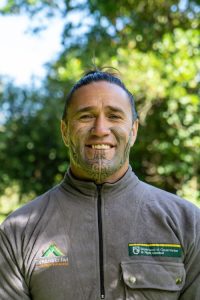
We are delighted to announce Ngahina Capper to the role of Operations Manager for Taranaki Mounga Project, starting in late April.
Ngahina is looking forward to being part of the project in the newly-created role, serving our tūpuna Mounga, and helping enhance the health and well-being of Te Papakura o Taranaki.
“I am excited about the opportunity of collaboration and partnership, the opportunity to work with iwi, hapū, key stakeholders and the community to collaborate on what the future might look like on our tūpuna Mounga for our tamariki and mokopuna,” he said.
For the past four years Ngahina has worked as Kaitiaki Whenua with Te Kāhui o Taranaki – a role that was initiated through a partnership with DOC, helping grow and develop its taiao team.
Prior to that he had nearly 20 years working in the mining and petrochemical industry across Australasia where he held a variety of leadership positions, before completing a stint as operations manager for Taranaki Rugby League.
Ngahina enjoys spending time with his whānau, including his seven children and one mokopuna, and has a new-found passion for helping establish his own whānau papakāinga. He also spends his spare time at rugby league and working with young people to help them reach their potential.
He has whakapapa to Te Ātiawa, Taranaki, Ngāti Ruanui, Ngā Ruahine, Ngāti Mutunga, Ngāti Tama, Ngāti Maru, Ngāti Maniapoto.
The Operations Manager role enables Co-Project Managers Sera Gibson and Sean Zieltjes to focus on the broader work programme of the project.
Sean says he is looking forward to having Ngahina on board. “We were really lucky with the high calibre of applicants we received and it puts us in a fantastic position for the future of Taranaki Mounga Project.”
Tech-savvy helping revitalise Kaitake
Tuesday, March 7th, 2023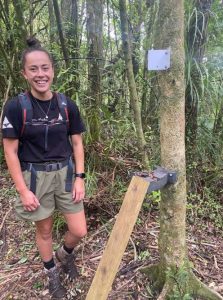
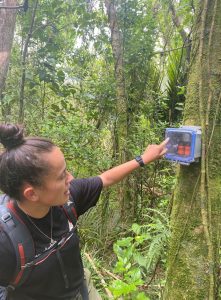
Ka whakamahi ana a Mereana i te pūngao hei whakaora i tōu tātou koroheke mounga. Ahakoa he uaua, ahakoa te kino o te kano-ā-rangi, ka whakakikī tonu tōna kete mātauranga.
Mereana Hanrahan never realised how much technology was involved in restoration efforts on Taranaki Mounga and the Kaitake Ranges.
“It’s been a big learning curve – it was really surprising how much tech was here,” she says, nearly two years into her role as an apprentice ranger with Taranaki Mounga Project.
The lingo – ‘sat’ box, nodes and Lean Detection System – rolls off her tongue as she explains some of the cutting edge tools and processes used by the team.
The Lean Detection System has been important for dramatically lowering possum numbers in the Kaitake Ranges and supporting native species to come back. Mereana explains that seeing more flowering kiekie is one example pointing to improved biodiversity – possums love to eat the sweet flowers so they used to be rarely seen.
The trapping system uses satellite technology, connecting leg-traps digitally via ‘nodes’. Rangers are alerted via their phones when a trap is set off. The Zip Outpost and Zip PosStop traps, developed and trialled by Zip, are simple, humane and save time, as traps don’t need to be unnecessarily checked.
“Just call us tech geniuses,” she jokes, as she explains some of the problem-solving required when things don’t work quite as they should.
Occasionally the signal can get blocked between traps, say from wind or fallen trees. That means walking up a trap line to figure out the problem and using a “tech in the bush” approach – trial and error working with the equipment and technology in the landscape.
There is also a network of cameras fixed to trees, providing data of how traps and lures are working and what predators are in the area -leading to identify increased numbers of feral cats.
Mereana says it’s physically demanding mahi, however she loves connecting with the whenua and the diversity of being a ranger, which includes helping DOC monitor native species like whio.
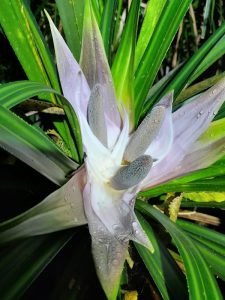
Flowering kiekie -a sign of improving biodiversity (credit: Shaun Baylis) and images above: Mereana Hanrahan with a legtrap and a satellite box on the Kaitake Ranges.
No pets please – we have kiwi
Sunday, December 11th, 2022Visitors to Mount Taranaki are being urged to obey the rules and leave their family pets at home, after Department of Conservation (DoC) staff observed jacket-wearing domestic cats being taken into Egmont National Park.
DoC Senior Ranger Dave Rogers says one of DoC’s staff did a double-take when she encountered pet cats wearing jackets and being carried in backpacks by their human owners on Mount Taranaki.
Cats and all other domestic animals are not allowed in the National Park as they pose a threat to endangered birds such as kiwi and whio, and other native species including geckos and insects.
The cats were in the carpark at North Egmont and were being put into the backpacks by their owners when approached by the ranger. The owners, visitors from Auckland, said they weren’t aware of the rules. The cat owners potentially face an infringement fine.
Read the full Stratford Press article here
Working collectively to tackle pest control
Wednesday, November 30th, 2022A unique tourist venture has joined forces with a Taranaki-based environment group to tackle pest control in one of the region’s more isolated spots.
Forgotten World Adventures, which runs converted golf carts along the former Stratford-Okahukura line, has collaborated with the East Taranaki Environment Collective (ETEC) to set up 69 pest animal traps along a 10km stretch of rail snaking through rugged hill country at Te Wera, which is 35 km east of Stratford.
Recently, representatives of ETEC, Forgotten World Adventures, Taranaki Kiwi Trust and Taranaki Mounga project placed traps alongside the rail line, at 150m intervals, from Mohakau Rd to the mouth of the tunnel under Pohokura Saddle.
The rail line runs along the southern boundary of pest management area ETEC operates within, which now covers more than 18,000 hectares from Okoki to Te Wera.
Read the full Taranaki Daily News article here.
Jan Hania moves onto Taranaki Mounga board
Tuesday, August 2nd, 2022 Since 2014 Taranaki Mounga Project Director Jan Hania (pictured) has been instrumental in developing and implementing our transformational 34,000-hectare landscape-scale project.
Since 2014 Taranaki Mounga Project Director Jan Hania (pictured) has been instrumental in developing and implementing our transformational 34,000-hectare landscape-scale project.
This week Jan moves from his role as Project Director to an Independent Director on our Taranaki Mounga Board.
Our team and board are delighted to continue to have his expertise and knowledge at this governance level.
“Jan through his role as the NEXT Foundation Environmental Director was a key driver in bringing together successful partnerships and an innovative model which has seen the revitalisation of our tupuna mounga,” says Taranaki Mounga Chair Jamie Tuuta.
“We are fortunate to have Jan join us on the Board as our project evolves and grows. He brings a wealth of skills, strong governance experience and provides continuity which is also vitally important.”
Taranaki Mounga continues to strive and align with the Government’s vision for a predator free New Zealand by 2050.
Our Co-Project Manager Sean Zieltjes will be Pouārahi Tupua / Acting Project Director and Sera Gibson will be in the sole acting role as Pou Whakahaere / Project Manager.
The Taranaki Mounga Board will confirm its new structure over the coming months and will advertise accordingly.
Underrated wonders of New Zealand
Thursday, June 30th, 2022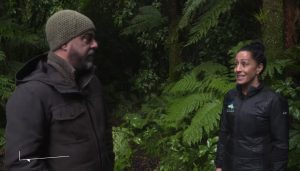 Our Co-Project Manager Sera Gibson made a cameo appearance on TVNZ’s Seven Sharp! This part of their Seven underrated wonders of New Zealand segment.
Our Co-Project Manager Sera Gibson made a cameo appearance on TVNZ’s Seven Sharp! This part of their Seven underrated wonders of New Zealand segment.New kiwi set to join successful Kaitake colony in Taranaki
Sunday, April 17th, 2022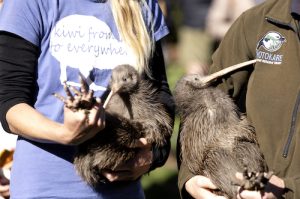
Two kiwi named Awhina and Craig were released at Pukeiti in the Kaitake Range last week. Photo – Andy Jackson
Eight kiwi have been set free into bush in the Kaitake Range in Taranaki, joining 10 released for the first time last year and which are now thriving and breeding.
The new arrivals, released on Thursday, will provide more genetic diversity for a new colony that is developing, Kaitake Ranges Conservation Trust chair Peter Morgan said.
Two more kiwi will join them this season, an exciting development for an area where no evidence of wild kiwi living had been found “for a very long time”, he said.
Intensive predator control by the trust has made it possible for the birds to be reintroduced, and more kiwi will be progressively released over the next few years.
Read the full Taranaki Daily News article here.
Kiwi release ‘season’ begins in Taranaki
Tuesday, March 29th, 2022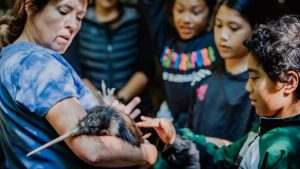
Sam Hopkirk, from Taranaki Kiwi Trust, and students Stevie-Lee Pauga 10, Naveah Makatea Cooper 10, and Turi Broughton-Rewiti 9, meet one of the birds released on Tuesday. Phoo- Vanessa Laurie
Kiwi release ‘season’ got under way with the release of five birds on Taranaki Maunga on Tuesday.
They were the first of 34 that will be moved out of the region’s kiwi nursery during April.
This is the third year that birds bred in the Taranaki Kohanga Kiwi At Rotokare, a partnership between the Taranaki Kiwi Trust and the Rotokare Reserve Trust, near Eltham, have been released.
The translocations are made possible by hundreds of volunteers working alongside staff from the two trusts and the Taranaki Mounga Project, Department of Conservation and the Kaitake Ranges Conservation Trust.
Read the full Taranaki Daily News article here.
It’s goodbye to goats in Te Papakura o Taranaki after 100 years
Friday, March 25th, 2022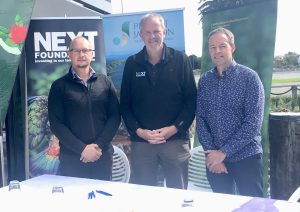
Taranaki Mounga board member Hemi Sundgren, NEXT Foundation chair and chief executive Bill Kermode, and DOC partnerships director Martin Rodd at the signing of the Tomorrow Accord on Friday.
After almost a century, goats are gone from Taranaki Maunga and the world’s longest-running goat eradication programme has come to an end.
Their absence is already being seen in an abundance of plants previously gobbled up by the goats.
This achievement was marked on Friday with a signing of the Tomorrow Accord milestone by representatives from the Taranaki Mounga Project (TMP) and Department of Conservation (DOC).
Established in 2014 between the Crown and Taranaki Mounga founding partner, the NEXT Foundation, the Tomorrow Accord ensures ecological transformations are protected for future generations.
Read the full Taranaki Daily News article here.
Kiwi now paired and prosper on Kaitake Range
Wednesday, February 9th, 2022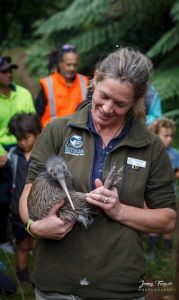
Rotokare Scenic Reserve Trust Conservation Manager Fiona Gordon. Photo – Jenny Feaver
In April last year 10 kiwi were translocated to the Kaitake Ranges. These kiwi were released with radio transmitters attached to their legs to allow Taranaki Kiwi Trust to monitor their survival and dispersal patterns.
Options considered for rebuilding Taranaki’s Lake Dive Hut
Friday, January 21st, 2022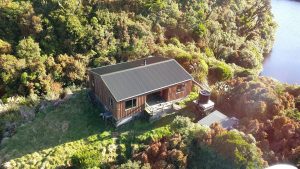
The 16-bunk Lake Dive Hut, burnt down in 2020 in a suspicious fire.
The Department of Conservation, local iwi, Federated Mountain Clubs and Back Country Trust are in discussions to explore opportunities for a potential rebuild of the popular Lake Dive Hut in Egmont National Park.
The 16-bunk Lake Dive Hut, on the slopes of Taranaki Maunga, burnt down in 2020 in a suspicious fire. A man alleged to have started the fire is now before the courts.
The local Department of Conservation (DoC) team is keen to see the hut replaced and staff are looking at possible options to achieve this, senior ranger Dave Rogers says.
“We recognise it leaves a fairly big gap in the backcountry hut network on that side of the mountain. Due to its stunning location and views of Taranaki Maunga, Lake Dive hut was a popular overnight destination. But like any organisation, DoC has a limited amount of funding, so we’re exploring rebuild options with potential partners.”
